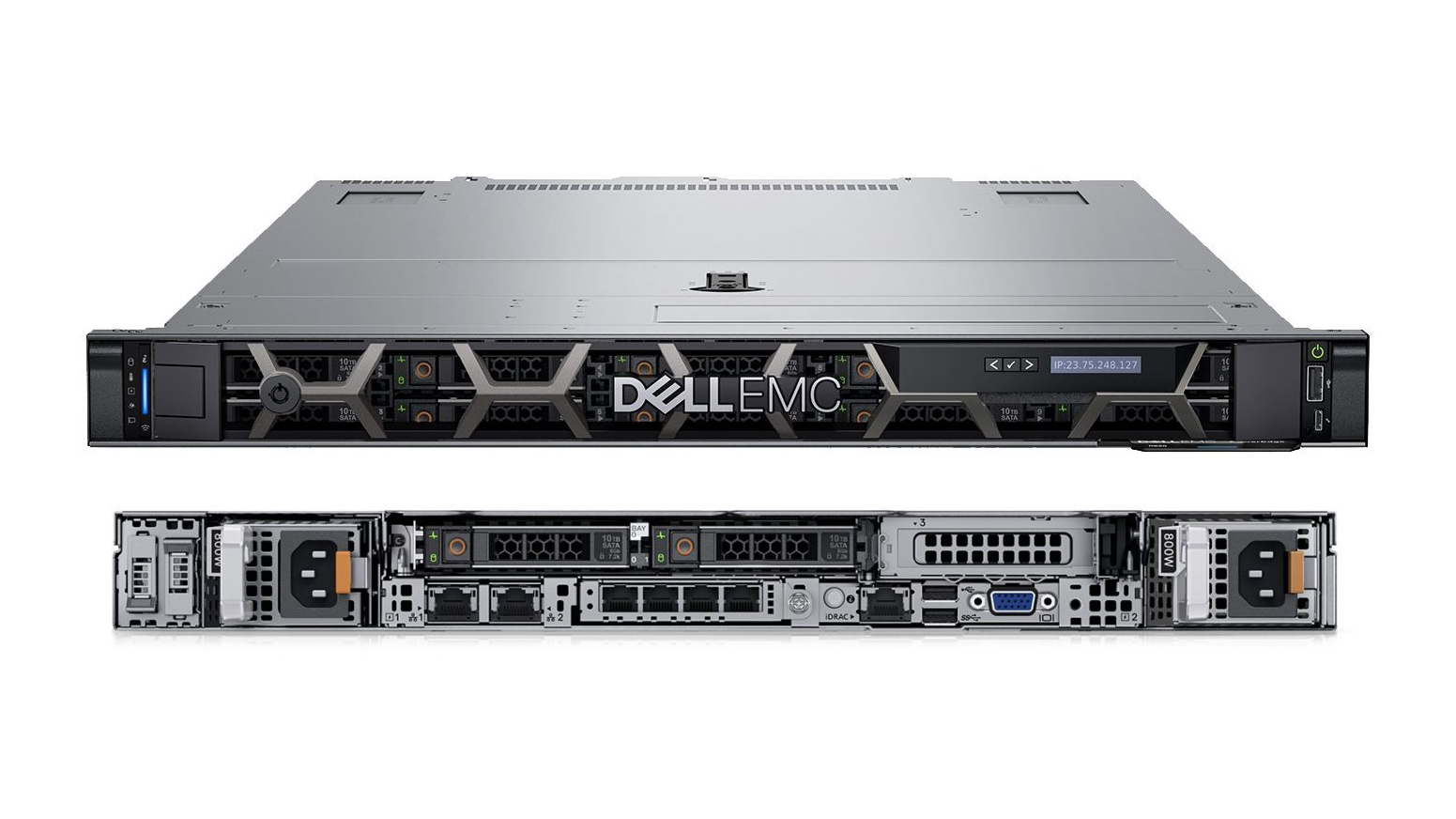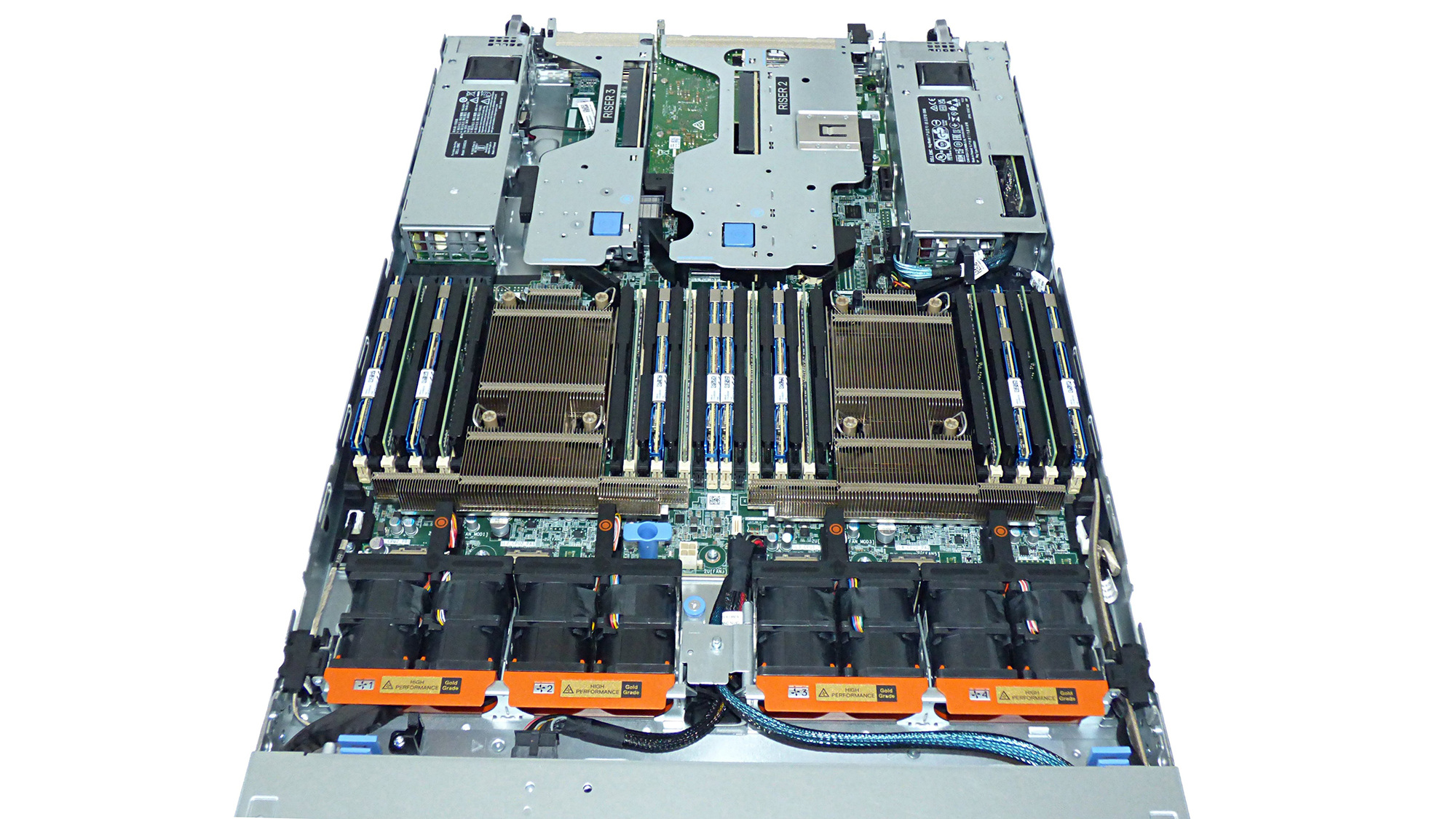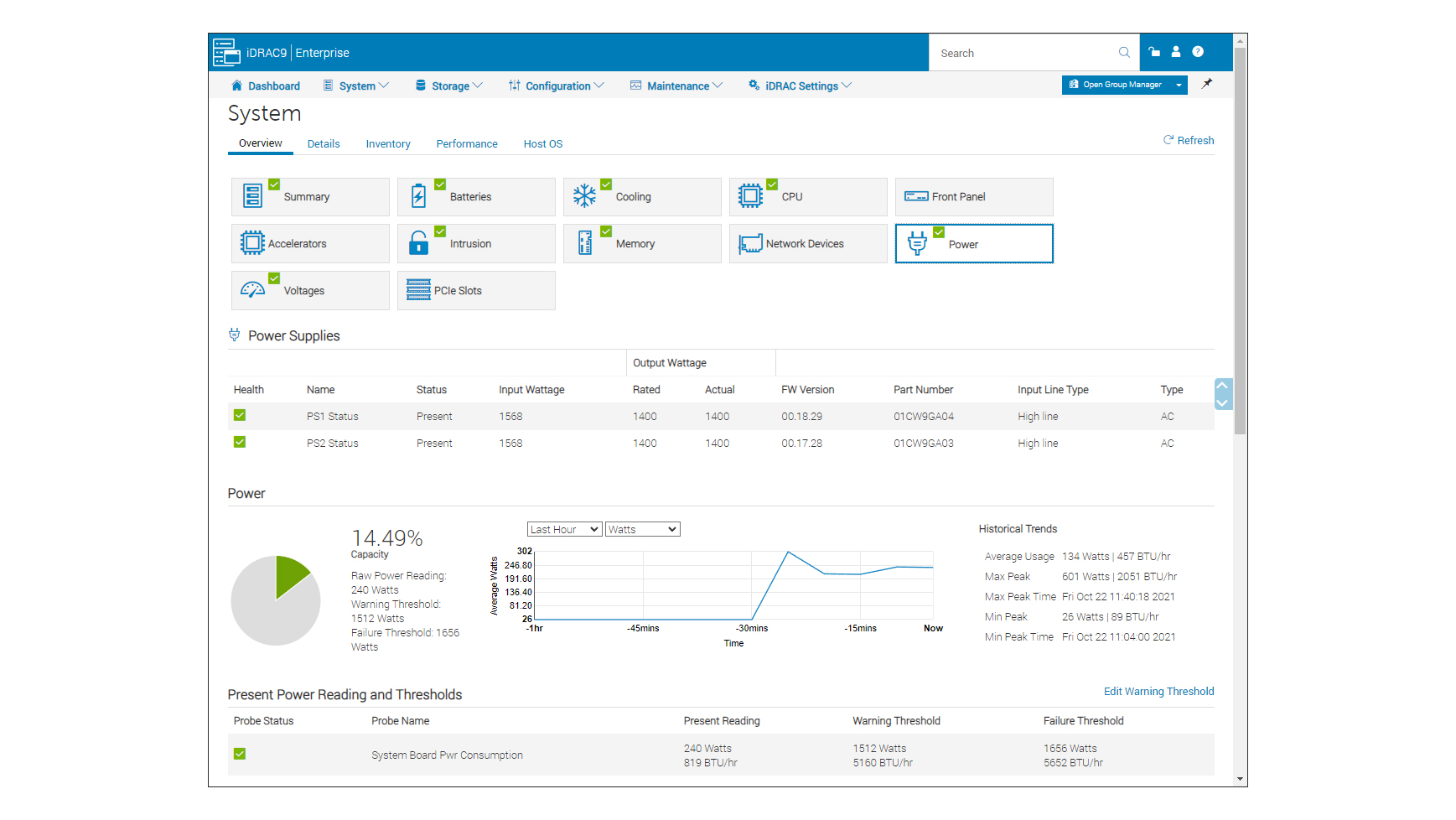Dell EMC PowerEdge R650 review: A slim and mighty server
Dell EMC takes server performance, expansion and processing density to new heights


-
+
Redesigned interior
-
+
Surprising expansion potential
-
+
Gen3 Xeon Scalable CPUs
-
+
Optane PMEM 200 memory support
-
+
Top-notch remote management facilities

Dell EMC is bringing high-density processing to a rack near you, thanks to a new PowerEdge R650 model which squeezes a remarkable specification in a low-profile 1U chassis. As you’d expect, support for Intel’s 3rd-generation Xeon Scalable CPUs gets top billing, but the R650 offers a lot more besides, including a sharp focus on improved internal design, increased expansion and more storage choices.
The system on review showcases these features nicely, and was supplied to us with a pair of 28-core 2GHz Intel Xeon Scalable Gold 6330 CPUs. Providing you’re prepared to limit your storage and expansion ambitions, it can also handle Intel’s top-dog 40-core Platinums and their thirsty 270W TDPs.
We also received a generous 256GB of 2,933MHz DDR4 memory, with the R650 supporting a maximum capacity of 2TB with RDIMMs and 4TB when using LR-DIMMs – but note that the R650xs model is optimised for virtualized environments and only has 16 DIMM slots. The R650 also supports up to 16 Intel Optane PMEM 200 modules and our system came with eight 128GB sticks nestling between the DIMM modules.
General storage options look good too, as along with a wide choice of embedded RAID controllers, the chassis can handle up to ten standard SAS/SATA SFF HDDs and SSDs, as well as NVMe SSDs. As with the older R640, it has room at the back for another 2-bay cage which also supports NVMe SSDs.
Dell EMC PowerEdge R650 review: Internal layout
Cracking the R650’s lid reveals a similar layout to the PowerEdge R750, as it too sports a T-shaped motherboard. Locating the PSUs on each side of the chassis reduces hotspots and the R650 uses smaller form-factor models, which allows extra exhaust lanes to be created to assist with CPU cooling.

All cooling is handled by a bank of fans in front of the motherboard and the type will be determined by a number of factors. Standard fans can be used if the CPUs have TDPs up to 165W, but the presence of the 205W TDP Gold 6330 CPUs and PMEM 200 memory in our system requires a bank of eight high-performance Gold fans. High power CPUs have slightly different T-shaped heatsinks that extend an extra radiator bar across their attendant bank of four fans. Dell EMC also offers a direct liquid cooling (DLC) kit for the R650 that features proprietary leak detection systems and shutdown services.
Overall, the internal design is very tidy, with the R650 affording easy access to all components for maintenance and upgrades. It’s put the extra room to good use too, as it offers a big memory boost over its predecessor with the DIMM slot count going from 24 to 32. On top of that, it supports 16 PMEM modules as opposed to 12.
Sign up today and you will receive a free copy of our Future Focus 2025 report - the leading guidance on AI, cybersecurity and other IT challenges as per 700+ senior executives
Dell EMC PowerEdge R650 review: Expansion and management
Expansion sees big improvements as well: along with three x16 PCI-E 4 slots, there’s room for an OCP 3.0 mezzanine edge slot, extending support to open-standard network cards from other partners, as well as Dell’s own offerings. RAID options get a major update too, as a dedicated slot on the backplane hosts the new PCI-E 4 PERC 11 controllers. We have the PERC H755 front SAS model on test, but other options include the PERC H755N, which allows the server to present a full house of NVMe SSDs.
The smaller PSUs also free up enough space to tuck the new BOSS (boot optimized storage solution) S2 card into the right-hand corner of the chassis. Conveniently, its dual M.2 SATA hot-swap carriers can be easily accessed from the rear without disturbing the server.
Speaking of convenience, remote server management doesn’t get any better than this, and the iDRAC9 controller offers a wealth of valuable features presented in a tidy web console. You can keep a close eye on all aspects of server operations, view performance and directly access its BIOS menus. Meanwhile, Dell EMC’s OpenManage Enterprise (OME) software presents a central console for managing all your servers with the Power Manager plug-in adding system consumption and thermal monitoring. The new CloudIQ hosted service even goes one step beyond this, linking up with OME via a plug-in and providing machine learning and predictive analytics for your entire infrastructure.

Dell EMC PowerEdge R650 review: PMEM 200 features and performance
You’re spoilt for choice when it comes to configuring Intel’s Optane PMEM 200 modules. They can be set up from the server’s BIOS boot menu, the iDRAC9 remote web management console, Windows PowerShell or Intel’s open-source IPMCTL utility. In all cases, you set your goal and choose between Memory Mode, App Direct or a mixture of both and set percentages for each mode. In App Direct mode, the R650 supports the BIOS-level option to apply encryption and passphrase protection to secure their contents.
To test pure PMEM storage performance, we created two interleaved App Direct regions each using four Optane modules so they were spread equally across the CPU’s memory channels. With Windows Server 2019 at the helm, we could see two 504GB persistent memory disks, which we used to create a single Storage Space with one mirrored virtual disk.
Performance is simply stunning. Iometer reported raw sequential read and write speeds of 47.6GB/sec and 3.8GB/sec, with random speeds settling at 41.8GB/sec and 3.9GB/sec. Dropping down to 4KB blocks saw great throughput numbers; Iometer returned sequential read and write rates of 1,110,655 and 773,160 IOPS while random operations returned 1,083,330 and 739,288 IOPS.
Dell EMC PowerEdge R650 review: Verdict
Organisations that want more power to their racks will find the PowerEdge R650 presents a great combination of high-performance CPUs, expansion potential and storage features in a space-saving 1U chassis. Internal design is exemplary, remote management features just keep on getting better and we found Intel’s Optane PMEM 200 modules in App Direct mode deliver a staggering storage performance.
Dell EMC PowerEdge R650 specifications (as reviewed)
| Chassis | 1U rack |
| CPU | 2 x 28-core 2GHz Intel Xeon Scalable Gold 6330 |
| Memory | 256GB 2,933MHz DDR4, 8 x 128GB Intel Optane PMEM 200 |
| Storage bays | 8 x SFF front hot-swap (max 12 with rear bays) |
| RAID | Dell PERC H755 front SAS |
| Storage included | None |
| Other Storage | Dell BOSS-S2 with 2 x 480GB M.2 SATA SSDs |
| Network | 2 x Gigabit, Intel 10GbE 4P X710 SFP+ OCP 3 |
| Expansion | 3 x PCI-E 4 x16 slots, 1 x OCP 3 slot |
| Power | 2 x 1,400W Platinum hot-plug PSUs |
| Management | Dell iDRAC9 Datacenter |
| Warranty | 3Yr Standard On-Site NBD |
Dave is an IT consultant and freelance journalist specialising in hands-on reviews of computer networking products covering all market sectors from small businesses to enterprises. Founder of Binary Testing Ltd – the UK’s premier independent network testing laboratory - Dave has over 45 years of experience in the IT industry.
Dave has produced many thousands of in-depth business networking product reviews from his lab which have been reproduced globally. Writing for ITPro and its sister title, PC Pro, he covers all areas of business IT infrastructure, including servers, storage, network security, data protection, cloud, infrastructure and services.
-
 Amazon says Russian-backed threat groups were responsible for five-year-long attacks on edge devices – and it shows a ‘clear evolution in tactics’
Amazon says Russian-backed threat groups were responsible for five-year-long attacks on edge devices – and it shows a ‘clear evolution in tactics’News Russian-backed hacker groups are exploiting misconfigured edge devices – now preferring that tactic over hunting down traditional vulnerabilities to gain access to company networks.
By Nicole Kobie Published
-
 UK government confirms October cyber breach: Everything we know so far
UK government confirms October cyber breach: Everything we know so farNews Details around Foreign Office hack remain sparse and government says it's unclear who is behind the attack
By Nicole Kobie Published
-
 Data center investment reached a record $61 billion this year
Data center investment reached a record $61 billion this yearNews Hyperscaler expansion, private equity interest, and a surge in debt financing are behind skyrocketing investment levels
By Emma Woollacott Published
